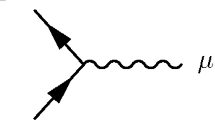Abstract
This paper examines the Stark effect, as a first order perturbation of manifestly covariant hydrogen-like bound states. These bound states are solutions to a relativistic Schrödinger equation with invariant evolution parameter, and represent mass eigenstates whose eigenvalues correspond to the well-known energy spectrum of the nonrelativistic theory. In analogy to the nonrelativistic case, the off-diagonal perturbation leads to a lifting of the degeneracy in the mass spectrum. In the covariant case, not only do the spectral lines split, but they acquire an imaginary part which is linear in the applied electric field, thus revealing induced bound state decay in first order perturbation theory. This imaginary part results from the coupling of the external field to the non-compact boost generator. In order to recover the conventional first order Stark splitting, we must include a scalar potential term. This term may be understood as a fifth gauge potential, which compensates for dependence of gauge transformations on the invariant evolution parameter.
Similar content being viewed by others
REFERENCES
P. A. Rejto, Helv. Phys. Acta 44, 708 (1971). P. A. Rejto and S. Sinha, Helv. Phys. Acta 49, 389 (1976).
E. Oks, A. Derevianko, and Ya. Ispolatov, J. Quant. Spectr. Rad. Transfer 54, 307 (1995). H. R. Griem, Contrib. Plasma Phys. 40, 46- 56 (2000). E. Oks, R. D. Bengtson, and J. Touma, Contrib. Plasma Phys. 40, 158- 161 (2000).
W. W. Jones and M. H. Miller, Phys. Rev. A 10, 1131 (1974).
C. Stehle, Astron. Astrophys. Suppl. Ser. 104, 509 (1994). C. Stehle and R. Huucheon, Astron. Astrophys. Suppl. Ser. 140, 93 (1999).
M. D. Bowden, V. P. Gavrilenko, T. Ikutake, J. B. Kim, H. J. Kim, and K. Muraoka, Contrib. Plasma Phys. 40, 113–119 (2000). P. I. Melnikov, J. B. Greenly, and D. A. Hammer, Active Stark Atomic Spectroscopy, http://xxx.tau.ac.il/abs/physics/9807008, private communication.
E. C. G. Stueckelberg, Helv. Phys. Acta 14, 322 (1941); Helv. Phys. Acta 14, 588 (1941).
L. P. Horwitz and C. Piron, Helv. Phys. Acta 48, 316 (1973).
V. A. Fock, Phys. Z. Sowjetunion 12, 404 (1937). R. P. Feynman, Rev. Mod. Phys. 20, 367 (1948); Phys. Rev. 80, 440 (1950). J. Schwinger, Phys. Rev. 82, 664 (1951). Y. Nambu, Prog. Theor. Phys. 5, 82 (1950). R. Fanchi, Phys. Rev. D 20, 3108 (1979). C. Dewdney, P. R. Holland, A. Kyprianides, and J. P. Vigier, Phys. Lett. A 113, 359 (1986). C. Dewdney, P. R. Holland, A. Kyprianides, and J. P. Vigier, Phys. Lett. A 114, 444 (1986). A. Kyprianides, Phys. Rep. 155, 1 (1986).
R. Arshansky and L. P. Horwitz, J. Math. Phys. 30, 66 (1989).
R. Arshansky and L. P. Horwitz, J. Math. Phys. 30, 380 (1989).
M. C. Land, R. Arshansky, and L. P. Horwitz, Found. Phys. 24, 563 (1994).
M. C. Land and L. P. Horwitz, J. Phys. A: Math. and Gen. 28, 3289 (1995).
D. Saad, L. P. Horwitz, and R. I. Arshansky, Found. Phys. 19, 1126 (1989).
R. Arshansky, L. P. Horwitz, and Y. Lavie, Found. Phys. 13, 1167 (1983).
M. C. Land and L. P. Horwitz, Found. Phys. Lett. 4, 61 (1991).
Author information
Authors and Affiliations
Rights and permissions
About this article
Cite this article
Land, M.C., Horwitz, L.P. The Covariant Stark Effect. Foundations of Physics 31, 967–991 (2001). https://doi.org/10.1023/A:1017516119084
Issue Date:
DOI: https://doi.org/10.1023/A:1017516119084



